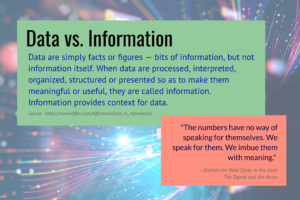Do you remember the story of the blind men and an elephant?
There have been several variations over the years. But the gist of the story is that some blind men come upon an elephant. The men have never been in contact with one before, so they use their sense of touch to determine what the elephant is.
- One feels the leg and determines it’s a tree
- One feels the side and believes it’s a wall
- One feels the ear and thinks it’s a fan
- And so on…
Each uses his limited data and makes a wrong determination as to what this thing that they are inspecting is.
There are different endings such as the men decide that the others aren’t telling the truth and decide to fight it out. Another is that a sighted man comes along and describes the elephant as a whole – while referencing the different aspects of the animal that the men found. The men then see that they were partially right – and partly wrong. One’s limited view may be correct, but it doesn’t necessarily give an accurate picture of the full truth.
Data vs. Information
We see this situation fairly frequently when it comes to data. Organizations may think that they have an understanding of what’s going on, but the reality is that they are making determinations based on limited, sometimes individual facts.
Take your fixed asset data, for example. Decisions may be made to budgets, operations plans, or resource allocations based on the inventory data that you have on hand.
But the reality of that data may be that it is partially right – but not entirely correct. You may own that tool (correct data element), but in fact, it’s not physically located where you think it is (incorrect data element). So planning for its use in that location could cause problems for your staff, or buying a replacement may be a better plan than trying to track that tool down at this moment. In any case, you’re making decisions based on individual data points – not complete Information.
Creating Information
I think everyone is familiar with the saying “garbage in, garbage out.” So the first step in creating Information is to ensure that the data that you enter is correct – and useful. That not only means that the individual elements are accurate, but that the data is complete and timely.
For example, when doing an inventory, does your staff just check a box or a list that an asset exists? Or are they physically looking at the item, noting its location, condition, other helpful facts, etc.? How quickly does that data get shared with your business systems? Is it days/weeks/months – or immediately?
Fixed asset inventory data is frequently not a priority given all of the other issues that demand an organization’s attention. However, the effects of looking at incomplete or inaccurate data can lead to wasting your staff’s time, spending money unnecessarily, or other avoidable results.
Tools for the Job
mobilePLUS was developed to create accurate fixed asset Information. It enables users to scan an asset quickly and easily wherever the asset is physically located. At the point of the scan, the user can flesh out the asset record with additional details like the condition and whatever else you need to know about it.
When they finish their inventory or audit activities, they can send the data they collected electronically to your ERP or business systems. As a result, your team has complete – and accurate – information to make reliable decisions for your business.
Ultimately, your decisions are only as reliable as the Information that you base them on. Doesn’t it make sense to ensure that the data that you gather creates quality Information – your elephant – and not just the suppositions of blind men?
Getting your fixed asset data in a trustworthy state is critical Information for any organization. Contact us if you aren’t sure where to start or want to look at the status of your asset information and procedures. Maybe we can help.





